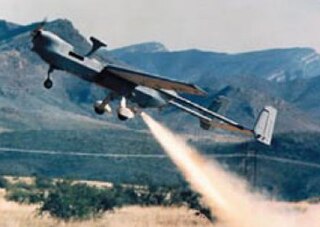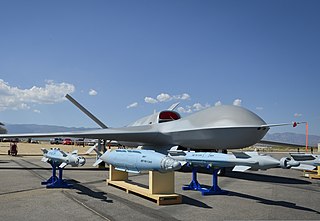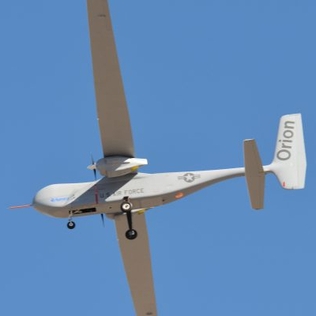
The IAI RQ-5 Hunter is an unmanned aerial vehicle (UAV) originally intended to serve as the United States Army's Short Range UAV system for division and corps commanders. It took off and landed on runways. It used a gimbaled EO/IR sensor to relay its video in real time via a second airborne Hunter over a C-band line-of-sight data link. The RQ-5 is based on the Hunter UAV that was developed by Israel Aerospace Industries.

The AAI RQ-7 Shadow is an American unmanned aerial vehicle (UAV) used by the United States Army, Australian Army, Swedish Army, Turkish Air Force and Italian Army for reconnaissance, surveillance, and target acquisition and battle damage assessment. Launched from a trailer-mounted pneumatic catapult, it is recovered with the aid of arresting gear similar to jets on an aircraft carrier. Its gimbal-mounted, digitally stabilized, liquid nitrogen-cooled electro-optical/infrared (EO/IR) camera relays video in real time via a C-band line-of-sight data link to the ground control station (GCS).

A miniature UAV, small UAV (SUAV), or drone is an unmanned aerial vehicle small enough to be man-portable. Smallest UAVs are called micro air vehicle.

An electric aircraft is an aircraft powered by electricity. Electric aircraft are seen as a way to reduce the environmental effects of aviation, providing zero emissions and quieter flights. Electricity may be supplied by a variety of methods, the most common being batteries. Most have electric motors driving propellers or turbines.
The Yarará project is the first unmanned aerial vehicle (UAV) programme in South America to be produced in series and for export. The system is developed by Nostromo Defensa for surveillance, border patrol and reconnaissance. It was unveiled at the Argentine Air Force Air Show on 10 August 2006. The manufacturer says it has been produced in small series for export to an unidentified government customer in the United States.

The General Atomics Altus is an unmanned aerial vehicle, designed for scientific research, built by General Atomics Aeronautical Systems (GA-ASI).

The flight endurance record is the longest amount of time an aircraft of a particular category spent in flight without landing. It can be a solo event, or multiple people can take turns piloting the aircraft, as long as all pilots remain in the aircraft. The limit initially was the amount of fuel that could be stored for the flight, but aerial refueling extended that parameter. Due to safety concerns, the Fédération Aéronautique Internationale (FAI) no longer recognizes new records for the duration of crewed airplane or glider flights and has never recognized any duration records for helicopters.

The Northrop Grumman Bat is a medium-altitude unmanned air vehicle originally developed for use by the United States Armed Forces. Designed primarily as an intelligence "ISR" gathering tool, the Bat features 30 lb (14 kg) payload capacity and a 10 ft (3.0 m) wing span.

The General Atomics MQ-1C Gray Eagle is a medium-altitude, long-endurance (MALE) unmanned aircraft system (UAS). It was developed by General Atomics Aeronautical Systems (GA-ASI) for the United States Army as an upgrade of the General Atomics MQ-1 Predator.

The Zephyr is a series of high-altitude platform station aircraft produced by Airbus. They were designed originally by QinetiQ, a commercial offshoot of the UK Ministry of Defence. In July 2010, the Zephyr 7 flew for 14 days. In March 2013, the project was sold to Airbus Defence and Space. In the summer of 2022, the Zephyr 8/S flew for 64 days.

The BAE Systems HERTI is an unmanned aerial vehicle (UAV) developed by the British company BAE Systems. HERTI stands for "High Endurance Rapid Technology Insertion" and was developed in Warton, United Kingdom. The HERTI airframe is based on the J-6 Fregata motor glider designed by Jaroslaw Janowski of J&AS Aero Design in Poland. Its first flight was in December 2004 at the Australian Woomera test range where much of the test flight programme has been undertaken. HERTI was also the first UAV to fly in the UK with the flight being certified by the Civil Aviation Authority.

A high-altitude platform station, also known as atmospheric satellite, is a long endurance, high altitude aircraft able to offer observation or communication services similarly to artificial satellites. Mostly unmanned aerial vehicles (UAVs), they remain aloft through atmospheric lift, either aerodynamic like airplanes, or aerostatic like airships or balloons. High-altitude long endurance (HALE) military drones can fly above 60,000 ft over 32 hours, while civil HAPS are radio stations at an altitude of 20 to 50 km above waypoints, for weeks.

The General Atomics MQ-20 Avenger is a developmental unmanned combat aerial vehicle built by General Atomics Aeronautical Systems for the U.S. military.

The Boeing Phantom Eye is a high altitude, long endurance (HALE) liquid hydrogen-powered unmanned aerial vehicle developed by Boeing Phantom Works. The aircraft was Boeing's proposal to meet the demand from the US military for unmanned drones designed to provide advanced intelligence and reconnaissance work, driven by the combat conditions in Afghanistan in particular. In August 2016, the Phantom Eye demonstrator was disassembled for display at the Air Force Flight Test Museum.
The AeroVironment Global Observer is a concept for a high-altitude, long endurance unmanned aerial vehicle, designed by AeroVironment (AV) to operate as a stratospheric geosynchronous satellite system with regional coverage.

The LTV L450F, also known as the L45ØF, was a prototype quiet reconnaissance aircraft, developed by Ling-Temco-Vought in the late 1960s for use in the Vietnam War by the United States. Based on the airframe of a Schweizer 2-32 sailplane, the aircraft flew in 1970, and was developed into the XQM-93 reconnaissance drone before the project was cancelled.

Singular Aircraft is a company with over 10 year experience dedicated to the design, development and manufacturing of Unmanned Aerial Systems (UAS).

The HESA Hamaseh is an Iranian tactical and reconnaissance unmanned aerial vehicle (UAV) with high flight endurance built by Iran Aircraft Manufacturing Industrial Company (HESA). The Hamaseh was unveiled in 2013 and entered service in 2016.

The Orion is a Medium-altitude long-endurance unmanned aerial vehicle (UAV) developed by Aurora Flight Sciences.

The TAI Aksungur is an unmanned combat aerial vehicle (UCAV) built by Turkish Aerospace Industries (TAI) for the Turkish Armed Forces. Using existing technology from the TAI Anka series of drones, it is the manufacturer's largest drone with payload capacity for mission-specific equipment. It is intended to be used for long-term surveillance, signals intelligence, maritime patrol missions, or as an unmanned combat aerial vehicle. TAI planned to integrate weapon packages and put the Aksungur into production in early 2020. The first unit was delivered to the Turkish Naval Forces on 20 October 2021.


















